Raspberry Pi 5 vs. Orange Pi 5 Plus vs. Rock 5 Model B
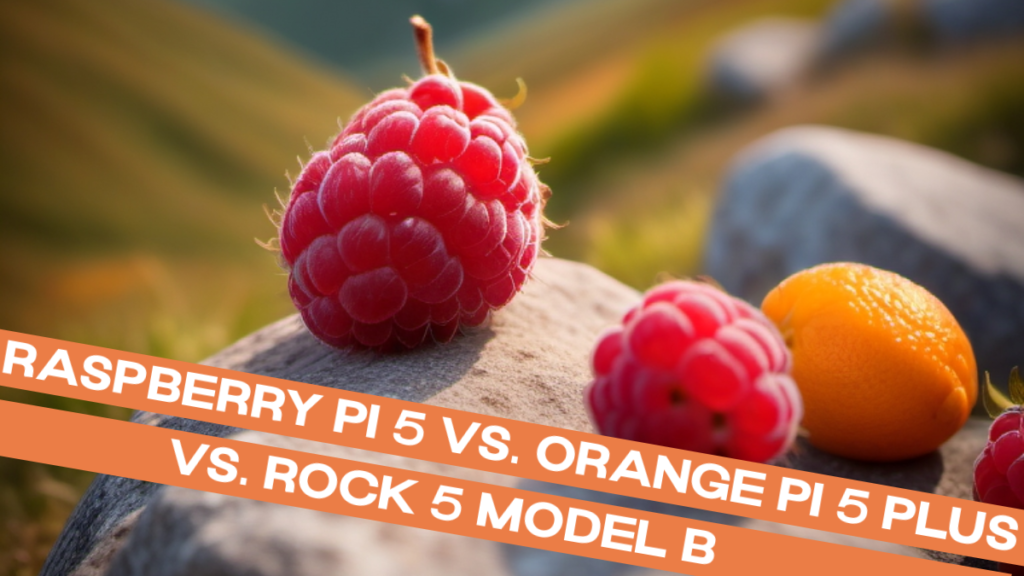
Met de aankondiging van de Raspberry Pi 5, brengt een nieuwe generatie nieuwe vragen met zich mee - zoals, hoe kan de Raspberry Pi 5 het opnemen tegen zijn concurrenten? In dit artikel wil ik het hebben over Raspberry Pi 5 vs. Orange Pi 5 Plus vs. Rock 5 Model B.
Ik moet iets bekennen. Mijn eerste Pi was eigenlijk een Orange Pi die ik in 2015 in Moskou kocht. Ik wilde een Pi-Hole opzetten op mijn thuisrouter. Op dat moment en op die locatie was het veel goedkoper om een Orange Pi te kopen dan een Raspberry Pi.
Sindsdien heb ik plichtsgetrouw de ontwikkelingen van zowel Orange Pis als Raspberry Pis gevolgd.
Dus nu Raspberry Pi een nieuwe generatie heeft uitgebracht, lijkt het me tijd om deze twee met elkaar te vergelijken. Dat zou echter geen recht doen aan de Rock 5 Model B, die in dezelfde categorie thuishoort.
Dus in dit artikel wil ik deze drie SBC's met elkaar vergelijken.
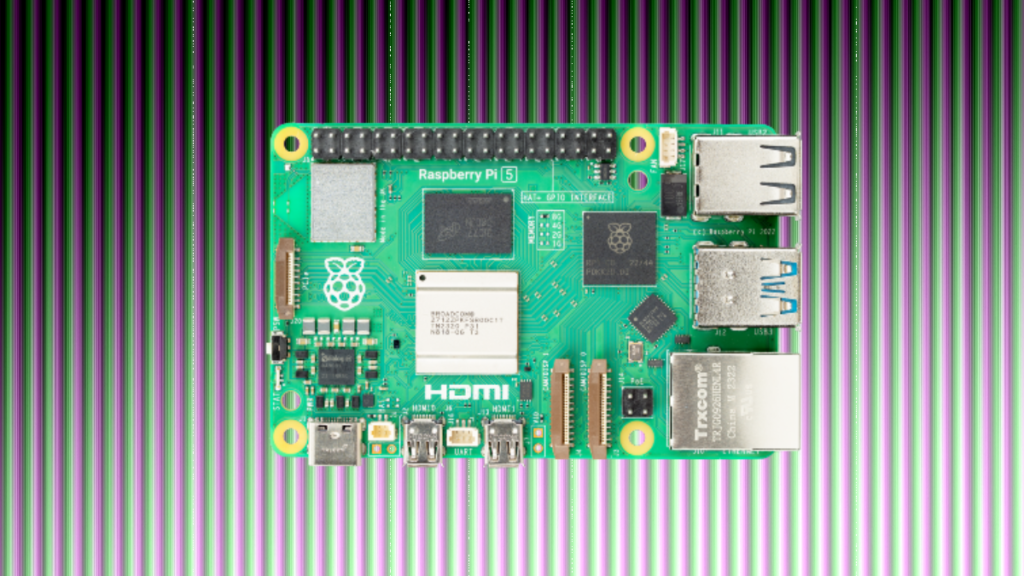
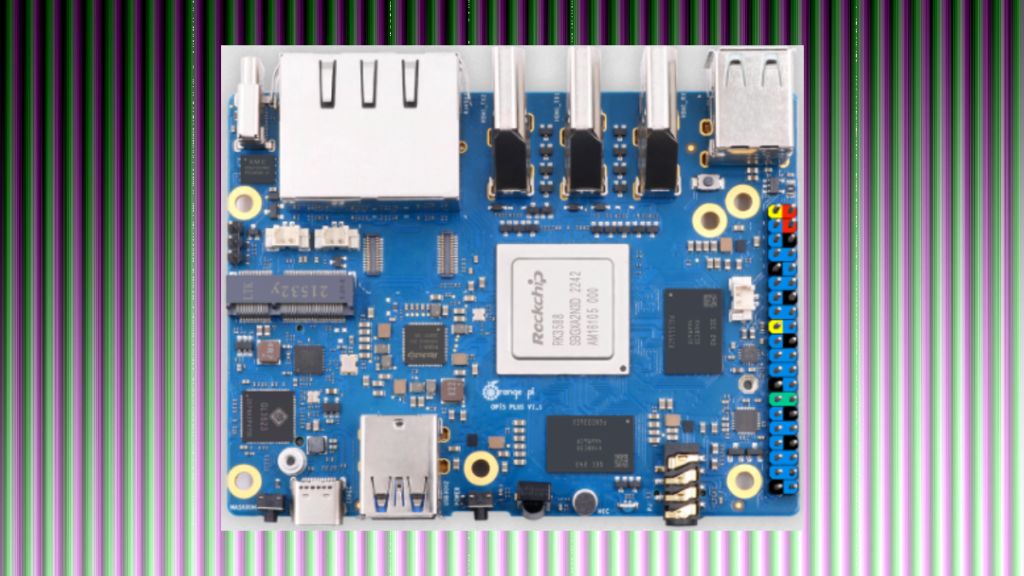
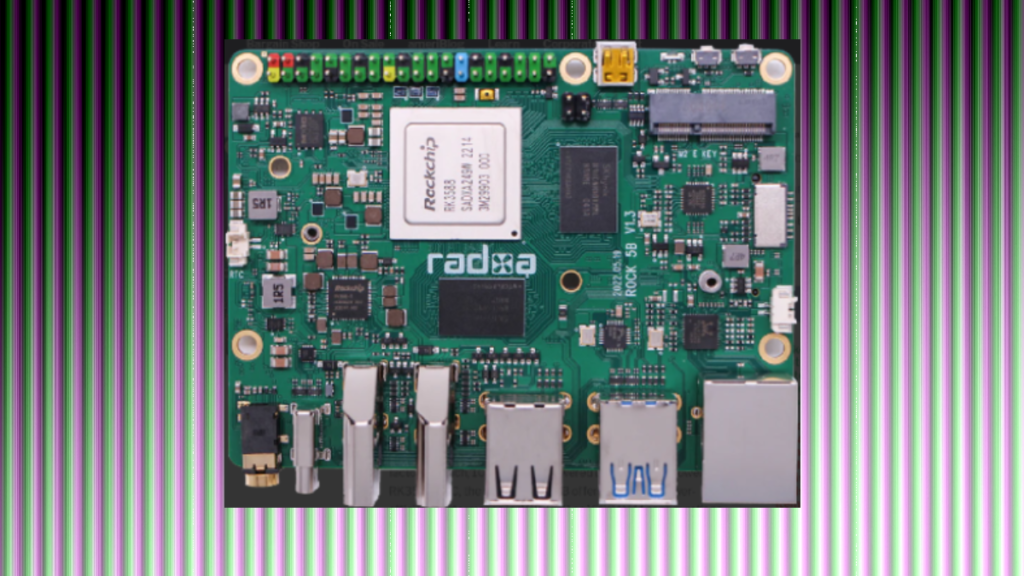
Specificaties
Laten we eerst eens kijken naar de specificaties.
| Raspberry Pi 5 | Oranje Pi 5 Plus | Rock 5 Model B | |
| SoC | BCM2712 | RK3588 | RK3588 |
| CPU | 4x ARM-schors-A76 | 4x ARM-schors-A76 4x ARM-schors-A55 | 4x ARM-schors-A76 4x ARM-schors-A55 |
| GPU | VideoCore VII | ARM Mali-G610 MP4 | ARM Mali-G610 MP4 |
| RAM | 4/8 GB LPDDR4X | 8/16/32GB LPDDR4X | 2/4/8/16/32GB LPDDR4X |
| Procesknooppunten | 16 nm | 8 nm | 8 nm |
| Opslag | 1x PCIe 2.0 micro SD-kaart | eMMC 1x M.2 (E-sleutel) 1x M.2 (M Key) micro SD-kaart | eMMC 1x M.2 (E-sleutel) 1x M.2 (M Key) micro SD-kaart |
| Netwerk | 1Gb Ethernet 2,4 GHz en 5,0 GHz 802.11ac Wi-Fi Bluetooth 5.0/BLE | 2x 2.5Gb Ethernet-poorten (Geen WiFi of Bluetooth aan boord) | 2,5Gb Ethernet (Geen WiFi of Bluetooth aan boord) |
| Video | 2x micro HDMI (4Kp60) 2x MIPI DSI/CSI | 2x HDMI (8Kp60) 1x HDMI-ingang (4Kp60) 1x MIPI DSI 1x MIPI CSI | 2x HDMI (8Kp60) 1x micro HDMI-ingang (4Kp60) 1x MIPI DSI 1x MIPI CSI |
| Audio | geen audio-aansluiting | audio-aansluiting ingebouwde microfoon | audio-aansluiting |
| USB | 2x USB 2.0 2x USB 3.0 | 2x USB 2.0 2x USB 3.0 1x USB 3.0 Type C | 2x USB 2.0 2x USB 3.0 |
| Vermogen | 5V/5A (USB-C) | 5V/4A (USB-C) | 5V/5A (USB-C) |
| Maat | 94x62mm | 100x70mm | 100x70mm |
| Aan/uit-knop | ✓ | ✓ | ✓ |
| RTC | ✓ | ✓ | ✓ |
De specificaties samenvatten
Het eerste dat moet worden opgemerkt is dat de Raspberry Pi 5 zich onderscheidt van de Orange Pi 5 Plus en Rock 5 Model B in de SoC.
Terwijl de Broadcom BCM2712 van Raspberry Pi 5 een vier-core ARM Cortex-A76 setup heeft met een VideoCore VII GPU, hebben Orange Pi en de Rock de RK3588 van RockChip, die acht kernen heeft en een ARM Mali-G610 MP4 GPU.
Deze acht kernen zijn opmerkelijk op de RK3588, omdat vier van hen ook ARM Cortex-A76 zijn, terwijl de andere vier ARM Cortex-A55 zijn.
Een ander ding dat snel opvalt zijn de verschillen in RAM-grootte. Bij de lancering heeft de Raspberry Pi 5 varianten van 4GB en 8GB (met 2GB onderweg en mogelijk 1GB in de toekomst). Ik heb ook discussies gezien over een mogelijke 16GB variant, maar niets officieels.
Orange Pi 5 Plus daarentegen gaat omhoog met 8GB als laagste variant en vervolgens 16GB en 32GB aan de bovenkant. Van wat ik heb gezien, heeft Rock 5 Model B het grootste bereik met opties voor 2, 4, 8, 16 en 32 GB.
Wat opslag betreft, hebben alle drie de SBC's micro SD-kaartsleuven.
Maar de Orange Pi 5 Plus en Rock 5 Model B hebben ook M.2 M Key en E Key slots. Hiermee kun je een WiFi-module aansluiten (geen van beide borden heeft WiFi aan boord) en opstarten via een NVMe SSD. Ze hebben ook eMMC-aansluitingen.
Raspberry Pi 5 heeft geen M.2 slots of eMMC sockets. Maar met de PCIe 2.0 lane uitgang is opstarten via NVMe SSD nu mogelijk.
Als het op netwerken aankomt, heeft de Raspberry Pi 5 WiFi op 2,4 GHz en 5,0 GHz 802.11ac aan boord, samen met Bluetooth 5.0 en Bluetooth Low Energy (BLE). Zoals ik hierboven al zei, hebben Orange Pi 5 Plus en Rock 5 Model B M.2 E Key-sleuven en bieden ze allebei modules die WiFi 6 en Bluetooth 5.2 kunnen krijgen.
U hoeft de modules alleen maar zelf te installeren.
Als het op video aankomt, is er een groot verschil tussen de drie.
Raspberry Pi 5 heeft twee micro HDMI poorten aan boord die gelijktijdig 4Kp60 kunnen leveren. Daarnaast heeft hij twee MIPI-aansluitingen die beide gebruikt kunnen worden voor camera en scherm.
Orange Pi 5 Plus heeft twee volledige HDMI-poorten aan boord die tot 8Kp60 kunnen leveren en een volledige HDMI-poort voor invoer die tot 4Kp60 kan leveren. Daarnaast heeft het een MIPI-aansluiting voor de camera en een aparte MIPI-aansluiting voor het beeldscherm.
Rock 5 Model B heeft twee ingebouwde volledige HDMI-poorten die tot 8Kp60 kunnen leveren. Maar het heeft ook een micro HDMI-poort voor invoer die tot 4Kp60 kan weergeven. Net als de Orange Pi heeft hij een speciale MIPI-aansluiting voor de camera en een aparte MIPI-aansluiting voor het beeldscherm.
Raspberry Pi heeft besloten om de audio-aansluiting voor het nieuwe model te schrappen. De Orange Pi 5 Plus en Rock 5 Model B hebben beide een audio-aansluiting.
Verder heeft de Raspberry Pi 5 twee USB 2.0-poorten, twee USB 3.0-poorten en een USB-C-poort voor voeding. Orange Pi 5 Plus wordt echter geleverd met twee USB 2.0-poorten, twee USB 3.0-poorten en een USB-C-poort voor voeding, en een USB 3.0 Type-C poort. Rock 5 Model B heeft twee USB 2.0-poorten, twee USB 3.0-poorten en een USB-C-poort voor voeding die ook als DisplayPort-uitgang kan fungeren.
Ze delen wel een aantal functies. Hoewel de drie borden iets verschillende voedingen hebben, werken ze allemaal op USB-C. Ze hebben allemaal een aan/uit-knop en een RTC.
Maar voordat we verder gaan met de benchmarks, is er één ding dat opvalt: de vormfactor.
Raspberry Pi 5 blijft binnen de standaard Raspberry Pi vlaggenschip familie met een afmeting van ongeveer 90mm x 60mm. De Orange Pi 5 Plus en Rock 5 Model B zijn echter duidelijk groter. Ze zijn ongeveer 100mm x 70mm (ook wel de Pico ITX vormfactor genoemd).
Benchmarks
In eerste instantie dacht ik erover om mijn eigen benchmarks voor deze drie borden op te stellen. Maar na wat nadenken besloot ik dat Jeff Geerling heeft eigenlijk alle belangrijke benchmarks gegeven in zijn recente video over de Raspberry Pi 5.
Dus, hoewel hij Orange Pi 5 gebruikt en niet Orange Pi 5 Plus, denk ik dat dit de benchmarks zijn die je betrouwbaar kunt verwachten van deze drie verschillende SBC's. Jeff neemt ook de Raspberry Pi 4 mee, zodat je kunt zien hoeveel meer krachtige Raspberry Pi 5 is.
Laten we eerst eens kijken naar de HPL benchmark, die de floating-point rekenkracht van alle drie de borden meet.
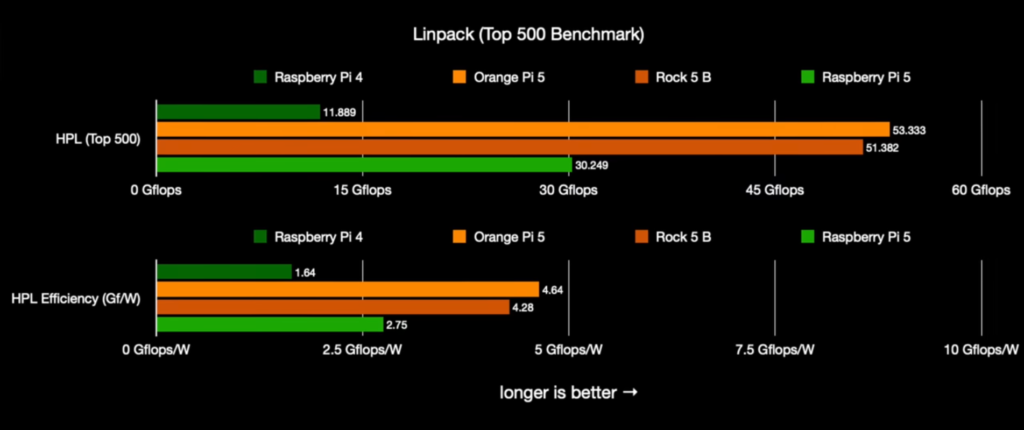
Deze benchmarks meten hoe snel elke SBC dichte lineaire vergelijkingen kan oplossen. Je zult zien dat de Orange Pi 5 en Rock 5 Model B de Raspberry Pis ver achter zich laten. Orange Pi 5 en Rock 5 Model B hebben meer dan 50 GigaFLOPS, oftewel 50 miljard floating point bewerkingen per seconde.
Ondertussen komt de Raspberry Pi 5 uit op ongeveer 30 GigaFLOPS.
De efficiëntie van de Orange Pi 5 en Rock 5 Model B is het dubbele van de efficiëntie van de Raspberry Pi 5. Efficiëntie verwijst in deze context naar hoe goed de HPL benchmark presteert in vergelijking met de theoretische piekprestaties.
Raspberry Pi 5 komt uit op 2,75 GigaFLOPS per Watt, terwijl Rock 5 Model B uitkomt op 4,28 GigaFLOPS per Watt. Ondertussen komt de Orange Pi 5 uit op 4,64 GigaFLOPS per Watt!
Jeff gaat dan naar twee benchmarks die ik erg waardeer. Namelijk hoe lang elk bord erover doet om MP3 te coderen en hoe lang het duurt om de Linux kernel te compileren.
In het eerste geval presteert Raspberry Pi zelfs beter dan Orange Pi 5 en Rock 5 Model B. Het converteert WAV-bestanden naar MP3-bestanden in minder dan 12 seconden. Orange Pi 5 en Rock 5 Model B hebben daarentegen beide iets meer dan 12 seconden nodig.
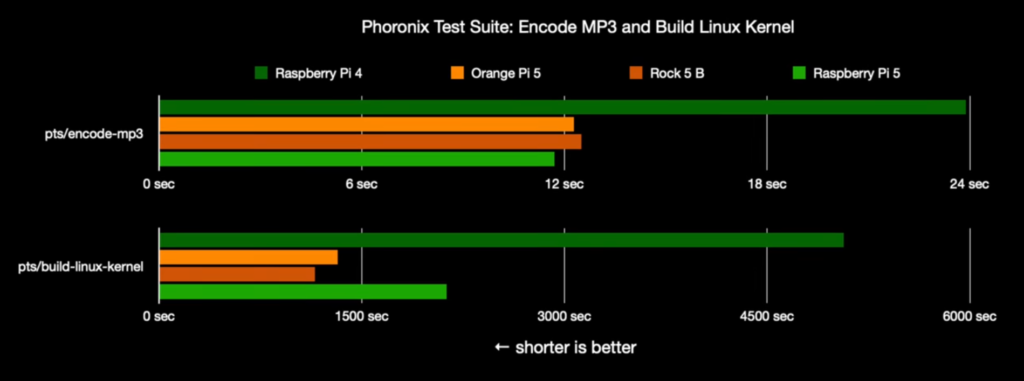
Bij het compileren van de Linux-kernel laten de Orange Pi 5 en Rock 5 Model B de Raspberry Pi 5 echter in het stof achter door dit in ruim onder de 1500 seconden te doen. Raspberry Pi 5 zit rond de 2000 seconden.
Maar er zijn nog meer benchmarks die het vermelden waard zijn.
Als het aankomt op het coderen van video, presteert de Raspberry Pi 5 veel beter dan de Orange Pi 5 en Rock 5 Model B. Als we kijken naar het coderen van media voor 4K-video, schommelen ze alle drie rond de 3,75 frames per seconde (waarbij de Raspberry Pi 4 iets rond de 1,5 frames per seconde zit).
De Orange Pi 5 en Rock 5 Model B presteren echter beter dan de Raspberry Pi 5 met videocodering voor 1080p video. Ze zitten allebei ruim boven de 20 frames per seconde, terwijl Raspberry Pi 5 niet eens 18 frames per seconde haalt.
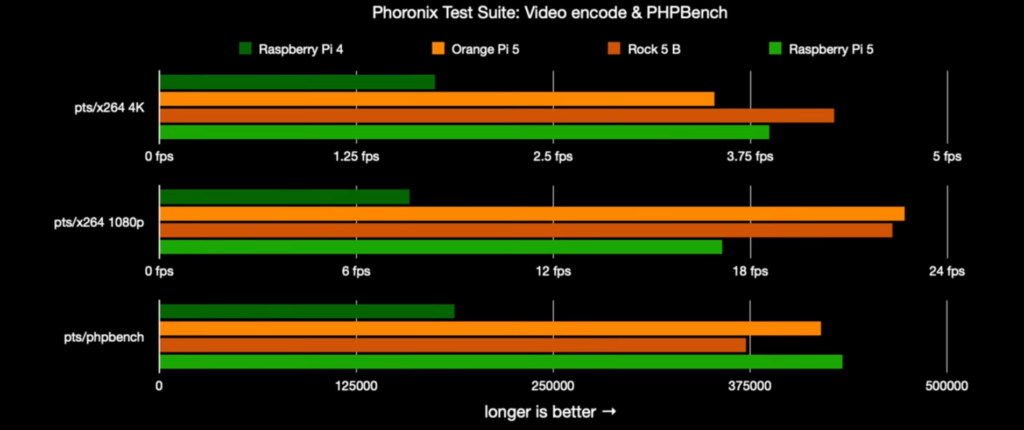
De PHP-benchmark op de Raspberry Pi 5 verslaat echter zowel de Orange Pi 5 als de Rock 5 Model B.
Desalniettemin zou ik zeggen dat de Orange Pi 5 en Rock 5 Model B het in de meeste belangrijke benchmarks behoorlijk beter doen dan de Raspberry Pi 5. En gezien hun grootte en prijs is dat natuurlijk niet echt verrassend.
Zoals Jeff het zegt in zijn video, "De Pi 5 is niet de koning op het gebied van SBC-prestaties, maar het houdt de Pi in de race deze generatie..."
Prijzen
Een van de belangrijkste verschillen tussen de drie SBC's is de prijs. Het is duidelijk dat Raspberry Pi een bepaalde hoeveelheid prestaties heeft ingeleverd om de kosten laag te houden.
Als we het over SBC's hebben, geven mensen vaak het officiële prijspunt. Ze zeggen dan bijvoorbeeld dat een Raspberry Pi 5 voor 8GB $80 kost. Maar dan zul je nooit een Raspberry Pi 5 vinden voor die prijs. Dat komt omdat dit de officiële prijs is en exclusief verzendkosten, belastingen of valutaschommelingen.
Dus ik dacht dat ik een beetje anders naar de prijs zou kijken.
Ik wil kijken naar Echt prijzen.
Maar dit betekent ook dat je moet kijken naar hoe deze bedrijven hun producten officieel verkopen, want als je de prijs gewoon door de markt laat bepalen, kan het vrij snel duur en onbetrouwbaar worden.
Houd er rekening mee dat ik in Duitsland ben, dus ik geef je prijzen in euro's.
Allereerst, als je een Orange Pi 5 Plus wilt kopen, verwijst het bedrijf zelf je door naar Amazon of AliExpress.
De prijs die ik vond bij AliExpress voor de Orange Pi 5 Plus met 16 GB RAM is € 153,27.
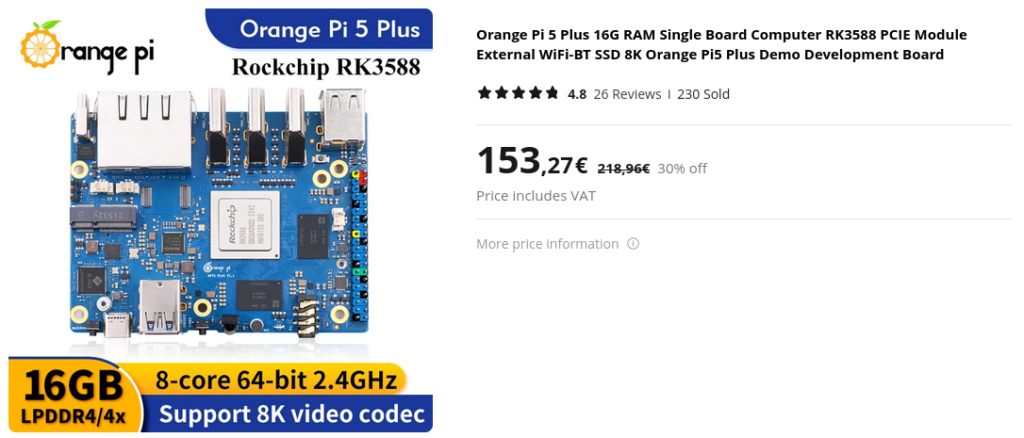
Als je een Rock 5 Model B wilt kopen, gaat het er iets anders aan toe. Radxa, het bedrijf achter Rock 5 Model B, heeft wat het noemt "geautoriseerde distributeurs". Voor zover ik kan zien op hun website zijn dat er vier: OKDO, Allnet, 3Logic en Ameridroid.
Nogmaals, ik ben in Duitsland, dus ik ging naar de Allnet-site voor Duitsland en vond dit:

De Rock 5 Model B met 16 GB kost € 301,63.
Nu is er een probleem - ik heb geen Orange Pi 5 Plus of een Rock 5 Model B met 8GB te koop kunnen vinden. En er is momenteel geen variant van de Raspberry Pi 5 met meer dan 8GB, dus het vergelijken van prijzen is een beetje raar. Maar het is de moeite waard om te kijken wat er beschikbaar is en wat niet.
Raspberry Pi heeft een vergelijkbare structuur als Radxa, maar met een veel groter bereik. Raspberry Pi heeft wat zij noemen "erkende wederverkopers" (en, volledige openbaarmakingWe zijn een erkende wederverkoper van Raspberry Pis).
Als je een goedgekeurde wederverkoperswebsite tegenkomt, weet je dat omdat ze een logo hebben dat er zo uitziet:

Hoe dan ook, we verkopen Raspberry Pi 5's voor 93,30€ bij ons zusterbedrijf - buyzero.de. Dat is beduidend goedkoper dan de andere twee, maar het is ook een kwestie van wat je zoekt.
Je zou kunnen zeggen dat we frambozen en peren vergelijken.
Afgezien van de grappen, als je meer dan 8GB RAM nodig hebt, dan heeft het op dit moment geen zin om voor Raspberry Pis te gaan. Als je echter op zoek bent naar een goedkopere prijs, dan zijn Raspberry Pis duidelijk de juiste keuze.
| Raspberry Pi 5 (8GB) | Oranje Pi 5 Plus (16GB) | Rock 5 Model B (16GB) | |
| Prijs | 93.30€ | 153.27€ | 301.63€ |
Wat ook de moeite waard is om te vermelden, is de compatibiliteit van software en de breedte van de community.
Het is duidelijk dat het ecosysteem en de gemeenschap van de Raspberry Pi veel sterker is dan die van de Orange Pi of Rock. Maar ik kan je in principe beloven dat de Orange Pi-gemeenschap en de Rock-gemeenschap beide zullen groeien in de komende jaren.
Dit zijn dus allemaal dingen om in gedachten te houden voordat je een SBC koopt.
Als je nog iets toe te voegen hebt, laat het me dan weten in de comments!
En vergeet onze wedstrijd niet - waarin we een volledige Raspberry Pi 5 kit weggeven aan de winnaar!
Wedstrijd & nieuwsbrief
We weten hoe frustrerend het is om tot 23 oktober te moeten wachten op een Raspberry Pi 5.
Daarom wilden we het voor jou mogelijk maken om er zo snel mogelijk mee te spelen.
Dus hebben we een wedstrijd opgezet: Wat is het gekste dat je kunt bedenken voor Raspberry Pi 5?

Op voorwaarde dat je idee het niet verpest, kun je ons jouw idee sturen en zullen we het op het onze toepassen. En we schrijven er een artikel over!
We maken de winnaar hier en op buyzero.de op 23 oktober.
Het winnende idee (door ons bepaald) wint een volledige Raspberry Pi 5 kit. Dit omvat een 27W USB-C Power Delivery (PD) voeding, een Raspberry Pi 5 behuizing, een SD-kaart en een Raspberry Pi 5. Alles met gratis verzending binnen de EU.
De runner-up wint een Raspberry Pi 5 met gratis verzending binnen de EU.
Stuur dus zeker je ideeën in. Ga naar de volgende link voor meer informatie: WIN EEN GRATIS RASPBERRY PI 5!
Conclusie
Dus als het aankomt op specificaties en benchmarks, hebben Orange Pi 5 Plus en Rock 5 Model B allebei duidelijk de overhand. Raspberry Pi heeft echter duidelijk prestaties ingeruild voor kosten.
Maar is een Raspberry Pi 5 na verzendkosten en belasting echt zoveel goedkoper dan een Orange Pi 5 Plus?
Het hangt er zeker vanaf waar je woont en welke deals je kunt vinden. Wat denk jij?
Ik ben echt een fan van alle drie de SGC's, maar ze hebben allemaal hun eigen tijd en plaats. Maar goed, ben ik iets vergeten? Laat het me weten!
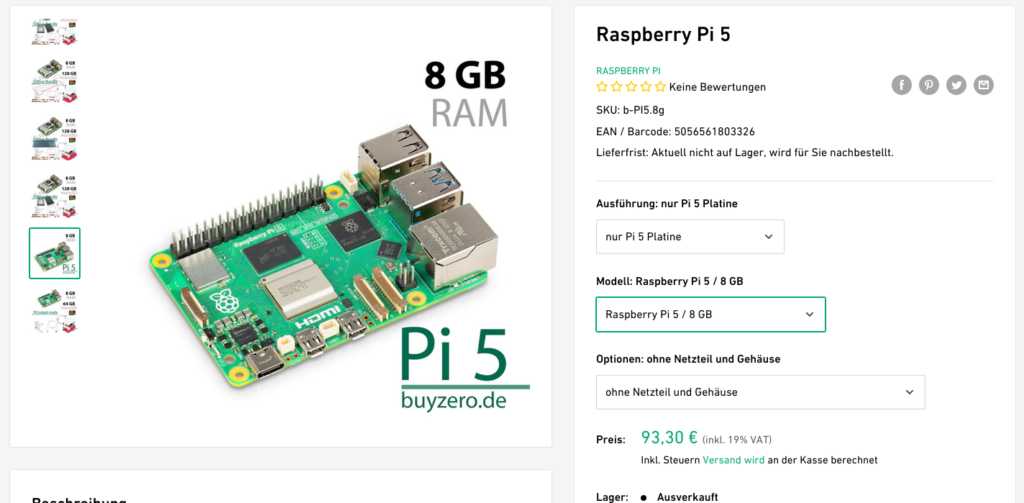
Hallo Adam,
Ik weet niet hoe je aan zulke prijzen bent gekomen, maar even zoeken geeft okdo de site met €189 voor 16G versie van Rock 5B, 8G is €153 voor nu. Dit is ook voorraad, reguliere prijs en okdo geeft van tijd tot tijd wat korting, haloween korting vorig jaar was 20% korting en ook radxa lanceerde in eerste instantie -$50 op preorders.
Absoluut de beste optie tot nu toe is friendlyelec met nano-pc t6. Het is zoiets als Rock 5B en opi 5+, maar met meegeleverde sleuf voor LTE (voor één usb3-poort) en optie met gesoldeerde eMMC die maar een paar dollar meer is. Voor $179 krijg je 16G RAM, 256GB eMMC en een geweldige cnc passieve koele behuizing.
Kortom, radxa-producten zijn gewoon duur, maar van tijd tot tijd ook afgeprijsd. FriendlyElec heeft altijd de beste prijs, terwijl orange pi de goedkoopste producten met basisspecificaties heeft.
Voor een eerlijke vergelijking kun je overwegen om een behuizing, koeling, voedingsadapter en opslagmogelijkheid toe te voegen. Op dit moment heb je voor de Pi5 ook een speciale oplader nodig en een kabel die 5V 5A kan leveren. In de toekomst heb je ook een pcie-naar-m.2 adapter nodig. Vroeg of laat zul je zien dat hun prijsmodel meer kost aan accessoires, terwijl anderen gewoon de standaarden volgen en niet iets anders hoeven te kopen bij de lancering.
Ik weet zeker dat pi5 verschillende dingen op de markt zal veranderen en rockchip en amlogic zouden daar een antwoord op moeten geven. Voorlopig lijkt de pi5 meer op de RK3588-printplaten in sommige opzichten beter en in andere niet.
oranje Pi de hele dag. Pi 5 zuigt. 1gbE is zielig man. absoluut verwerpelijke beslissing.
Sorry, maar ik ben het er niet mee eens. Ik vond de online ondersteuning voor OPi bedroevend slecht, vooral Ubuntu werd niet goed ondersteund en de mensen waren onvriendelijk en niet behulpzaam. EX: Ik zeg dat ik een probleem heb met Ubuntu, en het enige wat ik krijg is dat ik Ubuntu niet moet gebruiken, maar [vul maar in]; NIET HELPEND! Eén persoon stelde een code voor om te proberen en als ik die had geprobeerd, had ik mijn HDD gewist. Extreem NIET HELPEND!
Met andere woorden, het gaat niet alleen om het SGC, het gaat om de eigenaren van het SGC.
> het gaat over de SBC-eigenaren
Sommige mensen zijn niet geknipt voor het bloed, de ingewanden, de modder, de tranen, de pijn, het gevecht en de glorie van open source op niche ARM SBC's.
Sommige mensen kunnen dingen vinden die niet werken en ze dan repareren om bij te dragen aan de gemeenschap. Anderen kunnen de gemeenschap alleen maar naar beneden halen met eisen, zeuren, pesten en bedreigingen. Ja, er is overal kapotte software (en hardware).
Elke stapsgewijze stap die we kunnen zetten weg van de oligopolies van de computerkraken is waarschijnlijk te verkiezen. Laten we ons geld steken in bedrijven die op zijn minst proberen onze rechten als individuele mensen te respecteren.
Ik vind deze prijzen verbazingwekkend hoog voor wat je krijgt. Ik ga veel liever voor een Odroid H3+ of N2+. Ik snap dat de H3 vormfactor een beetje groter is, maar je krijgt 2 SATA poorten, veel cpu kracht en een zeer efficiënt energiegebruik.
Hoi Adam,
Bedankt voor deze geweldige vergelijking.
Ik tel gewoon drie punten op:
- de twee op rockchip gebaseerde SBC's bieden een veel snellere NVMe-connectiviteit (PCIe 3.0 x4 lanes vs. een verklaarde PCIe 2.0 x1 - en experimentele PCIe 3.0 x1 - van de raspi 5b)
- Bedrade snelheid is 2,5 vs 1 Gbps (er staat een verwijzing in de hoofdtabel, maar niet in het artikel)
- Radxa en Raspi hebben theoretische PoE-ondersteuning (nog geen kaart gevonden), Orange pi niet. PoE-niveau moet nog worden bepaald, maar het lijkt erop dat Raspberry 13W 802.3af PoE en 25W 802.3at PoE+ ondersteunt.
Ik denk niet dat het eerlijk is om de prijzen van Orange Pi plus vs RPi te vergelijken. Ik denk dat het veel eerlijker zou zijn om Orange Pi vs RPi te vergelijken. In dat geval blaast Orange Pi RPi uit het water terwijl het verkrijgbaar is bij Amazon Prime met zeer snelle verzending.
Hoi, denk je dat de Orange of de Rock voor een Plex-server beter overweg kunnen met streaming en transcodering dan een NAS-schijf met een Celeron CPU.
Nee. Hw-versnelling wordt (nog) niet ondersteund voor de rockchip. Coderen is slechts een optie.
Niet waar, met ubuntu gebaseerde distro's wordt ondersteund, ik heb een plex draaien met 2x 4tb externe ssd en 2tb intern + 256 Gb op nvme voor bestanden die ik nodig heb wanneer het ding opstart, alles werkt prima.
Orange Pi 5 plus heeft ook een microSD-kaartsleuf.
Ja, goed gezien - bedankt!
Ik ben zo verbaasd dat niemand de draadloze connectiviteit van de RPi5 heeft gewaardeerd. Zowel 802.11ac WiFi als BT5 zijn zo noodzakelijk voor een SBC.
beide kunnen desgewenst eenvoudig worden toegevoegd via usb of mini-pcie
Op Orpi5+ heb je een speciale wifi 6 bt 5.4 M2 kaart voor minder dan 15 USD verzendkosten inbegrepen, het heeft ook een IR sensor voor een remote conroler en heeft een HDMI in poort!
Ik zal nooit meer een Raspberry Pi kopen.
Hun prestaties zijn gewoon zo ongelooflijk slecht.
Wat echt ontbreekt in deze vergelijking is softwareondersteuning en -kwaliteit. De rk3588-borden zijn erg snel, dat klopt, maar de softwarekwaliteit is erg laag. Je hebt de keuze tussen haastig in elkaar gezette hacky en verouderde Android of Linux, en leveranciers van derden die het moeilijk hebben om nette ondersteuning te bieden. Op dat gebied en in de ondersteuning van de gemeenschap blaast de Raspberry de concurrenten uit het raam.
Goed punt, Panca - ik ben het eens met 100%.
Wat?
Waar heb je het in vredesnaam (of waar dan ook) over?
Zo werkt het gewoon niet.
Waar haal je deze onzin vandaan?
Het is dezelfde software en ik betwijfel ten zeerste of "haastig in elkaar gezet krakkemikkig en verouderd..." ook maar enigszins waar is.
Heb je enig bewijs om je ongegronde beweringen te ondersteunen? Nee? Geen enkel? Zelfs geen voorbeeld dat je kunt geven? Ik dacht het niet.
Helemaal waar. Ik heb enkele honderden gigabytes van hun rk** developer kit gedownload. Ik was verrast door de haast waarmee het eruit stak. Nou het werkt allemaal toch? Misschien zijn er te weinig medewerkers.
Bedankt voor het opnieuw plaatsen van de benchmarks. Ik heb de Orange Pi 5 vermeld zien staan als RK3588S en de plus als RK3588. Dit zijn verschillende versies van de processor met verschillende prestaties. Als ze inderdaad verschillende processors hebben, kan het nuttig zijn om een extra set benchmarks te doen.
Ik zou ook een vergelijking met een Intel N100 aanraden (de RK3588 is de beste in Passmark en blaast de meeste i3 en sommige Celeron en andere Intel CPU's uit het lagere segment uit het water).
Maar dat (en dat is ongeveer $20 in de VS via Amazon) moet je bij de bouwkosten optellen. Als er betaalbaar WiFi 6/BT/5G zou zijn dat zou werken (en het vinden van HCL voor Orange Pi 5 voor randapparatuur is geen sinecure, en hun klantenservice reageert niet altijd op vragen over dingen zoals welke cameramodules van andere bedrijven werken), zou dat nog een betere manier zijn om te gaan (ik kan onbeperkt 5G-internet krijgen voor ongeveer $50/mo).
Wat benchmarks betreft, zou je Steam kunnen proberen en kijken of je een Windows-titel kunt draaien met Steam's WINE. Hoewel ik niet denk dat de Playstation5 zich zorgen zal maken, als je Steam-games en andere games kunt draaien met redelijke prestaties (>30FPS, idealiter 60-100; ik weet niet of het menselijk oog veel meer dan 60 kan waarnemen, wat precies op het randje is van hoe snel het netvlies kan verversen).
Tot slot is er nog een andere kwestie, namelijk de keuze van het besturingssysteem. Met RPi was er een groeiend aantal Linux distributies (en ik denk zelfs Windows, als je dat soort dingen doet) voor RPi, ik denk niet dat het laden van openSUSE w / LXQt (mijn huidige voorkeur RPi desktop OS) op Orange Pi veel plezier gaat opleveren.
Orange PI lijkt een Arch-gebaseerde distro te hebben die ingebouwde ondersteuning voor Android heeft (en als WINE werkt, dan ook Windows.) Dit zou je toegang geven tot een breed scala aan titels, waarvan sommige zelfs een bruikbare UI op een desktop zouden kunnen hebben (bijvoorbeeld software die is ontworpen om te werken met Samsung's desktop mode). Ik weet niet 100% zeker waarom mainstream Linux distro's geen Android app opties bieden (je kunt zelf aan de slag) omdat het een vrij grote toename van het aantal softwaretitels zou zijn (hoewel, ik moet toegeven, ik heb nog niet elke applicatie getest die beschikbaar is in alleen de openSUSE repositories - meer dan 400K denk ik, dus het zal enige tijd duren). De mogelijkheid om Debian te gebruiken (de enige distro met meer pakketten dan openSUSE) was altijd een pluspunt voor de RPi, omdat veel pakketten zijn geport. OpenSUSE, dat een multi-target build systeem heeft (dat andere distro's gebruiken), laat een repository manager gewoon kiezen voor welke platformen hij wil bouwen, inclusief Arm64 (of Arm8, RISC, PowerPC, IBM Z series, etc.) dus er waren veel RPi opties (plus, het is mijn dagelijkse desktop OS).